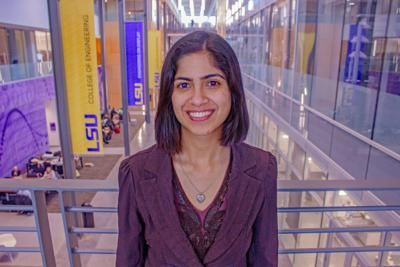Imagine if oil and gas companies were able to detect a leak before marine life, and sometimes human life, were destroyed.
LSU Petroleum Engineering Assistant Professor Jyotsna Sharma is helping make this possible through her research, funded by a $750,000 grant from the Department of Energy, using quantum-enhanced fiber sensing for oil and gas applications.
Sharma, who also serves as the Devon Energy Career Development Professor at LSU, is working alongside University of Oklahoma Physics and Astronomy Associate Professor Alberto Marino to develop a quantum-sensing approach that is compatible with current infrastructure in the oil and gas industry and can outperform the current state-of-the-art techniques.
“A major area of concern in the oil and gas industry is preventing environmental contamination caused by subsurface leaks due to well integrity issues and surface spillage through the millions of miles of surface, underground, and subsea pipelines that accrue over years,” Sharma said in an announcement detailing her work. “This spillage causes ecological damage, human casualties, and economic loss.”
Current commercial techniques for leakage detection are limited by environmental and background noise and don’t offer enough sensitivity to detect small leaks. Such noises include pump- and fluid-handling noise and waves in offshore operations.
“We will use quantum states of light to enhance the sensitivity of fiber-optic leakage sensors,” Sharma said. “We believe that the recent developments in quantum information science can lead to a paradigm shift in the field with the potential for a large impact for oil and gas applications through improvements in monitoring technology for earlier identification and warning.”
Sharma, who is co-principal investigator on the project, and Marino (principal investigator) are working with Oak Ridge National Laboratory on the three-year project. After performing initial tests at the lab, the team will then test the developed quantum techniques under real-life conditions at the 5,000-ft.-deep high-pressure test well, instrumented with fiber-optic sensors, at LSU’s Petroleum Engineering Research, Training, & Testing (PERTT) Lab.


